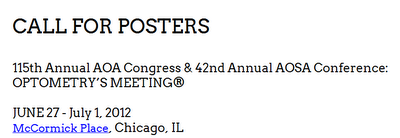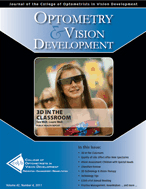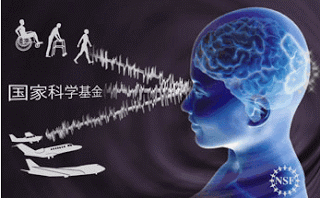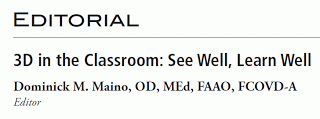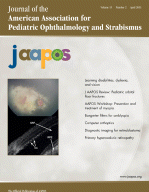Detecting the serious visual disorders of childhood
....Vision is important throughout childhood, leading early developmental
progress, supporting academic achievement and enhancing the general
quality of life. This article is directed towards the early identification of
the serious ocular problems which may arise in children. General
screening and assessment are discussed, including important pointers
in the history and examination. Selected topics include the baby who
cannot see, refractive errors and strabismus, nystagmus, cloudy or prominent
eyes, and trauma.....
Comments: Free PDF available. DM
MainosMemos contains the latest research and information about eye and vision care of children, developmental disabilities, Traumatic/Acquired Brain Injury and other topics of interest to me (and hopefully you!).
Saturday, January 7, 2012
Friday, January 6, 2012
The accommodative lag of the young hyperopic patient
The accommodative lag of the young hyperopic patient
...These data from a relatively small but broad sampling of age and clinical status suggest that clinically normal young infants and children with low amounts of hyperopia have similar lags of accommodation from the first few months after birth. Subjects with greater than 4 D of hyperopia, or amblyopia or strabismus, have more variable lags and therefore evidence of abnormal visual experience....
Analysis of the Accuracy of Noncycloplegic Retinoscopy, Retinomax Autorefractor and SureSight Vision Screener for Preschool Vision Screening
Analysis of the Accuracy of Noncycloplegic Retinoscopy, Retinomax Autorefractor and SureSight Vision Screener for Preschool Vision Screening
.....NCR, Retinomax and SureSight had similar and high accuracy in detecting vision disorders in preschoolers across all types of screeners and age of child, consistent with our previously reported results at specificity levels of 90% and 94%......
Thursday, January 5, 2012
AOA Call for Posters
American Optometric Association Call for Posters.
Abstracts based on unique clinical cases and all aspects of optometric research are currently being accepted. All case reports and research must be complete and unpublished at the time of submission. All abstracts must be submitted electronically via online submission by February 3, 2012. Click Here. for more information.
Abstracts based on unique clinical cases and all aspects of optometric research are currently being accepted. All case reports and research must be complete and unpublished at the time of submission. All abstracts must be submitted electronically via online submission by February 3, 2012. Click Here. for more information.
Lazy Eye can Improve With Gaming
Lazy Eye can Improve With Gaming
....Optometry research has been looking at new ways to treat the highly common disorder of lazy eye. While eye patches were long believed to be the only, if imperfect, solution to this problem, new studies have reinforced the notion that having patients play video games could result even greater outcomes.
Amblyopia, also known as lazy eye, is a neurological disorder where the vision in one eye does not develop properly. It is a major cause of permanent visual impairment in childhood and affects nearly three percent of children, according to the National Eye Institute. It is also the most common cause of one-eye visual impairment among young and middle-aged adults. Read More............Recent research has shown that video games could also help adults affected by the condition. In a study from the School of Optometry and the Helen Willis Neuroscience Institute at the University of California, Berkley, researchers found that playing commercial video games had a noticeable impact on participants. Subjects in the lazy eye treatment pilot project experienced significant improvements in visual acuity and 3D depth perception after just 40 hours of gaming......
Comments: Amblyopia can be improved at any age. Do not let any doctor tell you different. Want more info? Go to http://www.covd.orghttp://www.covd.org. DM
Wednesday, January 4, 2012
Tuesday, January 3, 2012
Optometry & Vision Development volume 42 #4 Now Online
3D in the Classroom: See Well, Learn Well
by Dominick M. Maino, OD, MEd, FAAO, FCOVD-A, Editor
 It all started around 300 BC when Euclid first
It all started around 300 BC when Euclid firstobserved that each eye binocular sees an image from a slightly different perspective. Italian Maestro, Leonardo da Vinci in the 1500’s then realized that having two eyes gave us a sense of depth and an ability to perceive distance. Later in the 1800’s Sir David Brewster (of the Brewster Stereoscope fame), Sir Charles Wheatstone (of the Wheatstone Stereoscope fame) and American jurist, author and inventor, Oliver Wendell Holmes (who brought 3D to the masses with his inexpensive Stereopticon) made it possible for many to experience simulated 3D images. ......
Comments: Read more by clicking the title above. DM
Monocular and Binocular Accommodative Flipper Rock Optometric Vision Therapy
Monocular and Binocular Accommodative Flipper Rock optometric vision
therapy can be conducted in and out of the optometrist's office as a
therapeutic intervention for focusing disorders. The primary focusing
dysfunction this procedure treats is accommodative infacility (a problem
shifting your focus from near to far and back again). Two of my
students developed this video with a bit of editing assistance on my
part. This video may be used by all for non-commercial purposes only.
Always consult your doctor before beginning any therapy or intervention
program.
Monday, January 2, 2012
THX and Optometry College Set Up One-Person 3D Theater
THX and Optometry College Set Up One-Person 3D Theater
My friend and colleague in all things 3D, Phil Lelyveld, notes that: THX has provided equipment and setup assistance to a special eye clinic just opened in Beaverton, Oregon by Pacific University’s College of Optometry. It is the nation’s first 3D eye exam room to help people with depth perception problems, and hopes also to provide information to the 3D industry to improve the methods they use to display 3D to audiences. The clinic is already discovering what it is about viewing 3D that causes some people to have eye problems.....
Comments: Click on the title above to read more. DM
Physicians and Self-Prescribing: Just Say ‘No’
Physicians and Self-Prescribing: Just Say ‘No’
....There is great uncertainty and misunderstanding in the United States regarding whether or not physicians are allowed to self-prescribe. Under federal law, physicians are not specifically prohibited from self-prescribing or prescribing for friends and family. According the Opinion 8.19 of the AMA Code of Medical Ethics, “physicians generally should not treat themselves or members of their immediate families.” The AMA cites the following reasons:....
Comments: Click on title to read all about this potential dilemma. DM
Sunday, January 1, 2012
COVD 41st Annual Meeting Papers and Posters
The following presentations and posters were presented during the 2011 COVD 41st Annual Meeting in Las Vegas, Nevada.
Oral Research Presentations
The Fischer Fixtest for Fixation and Saccade Reaction Time Differentiates
Between Symptomatic and Asymptomatic Adult Patients
Darrell G. Schlange, OD, Illinois College of Optometry, Illinois Eye Institute; Dominick Maino, OD, MEd, Illinois College of Optometry, Illinois Eye Institute, Chicago, IL; Brian Caden, OD, MA, Illinois College of Optometry, Illinois Eye Institute, Chicago IL
The Effect of Successful Treatment of Symptomatic Convergence Insuff iciency on Reading Performance in School-Aged Children
Mitchell Scheiman, Christopher Chase, G. Lynn Mitchell, Eric Borsting, Marjean Kulp, Susan Cotter, and CITT-RS Study Group
Correlation Of Reading Fluency With Visual Motion Sensitivity Tests, Reading Rate, And Pseudoword Decoding
Barry Tannen, OD, FAAO, FCOVD, Associate Clinical Professor, SUNY/State College of
Optometry; Amy Bartal, OD, Resident in Vision Therapy and Rehabilitation, EyeCare
Professionals, PC; John Shelley-Tremblay, PhD, Associate Professor, Department of Psychology,
University of South Alabama; Kenneth J Ciuffreda, OD, PhD, FCOVD-A, Distinguished
Professor-SUNY/State College of Optometry; Steve Larson, OD, PhD, Assistant Professor,
SUNY/State College of Optometry
Visual, Electroencephalographic And Behavioral Differences In Individuals Scoring Low And High On Attention Measures Used In The Diagnosis Of ADHD
Dmitri Poltavski, PhD, Assistant Professor of Psychology; David Biberdorf, OD, Valley Vision Clinic; Thomas Petros, PhD, University of North Dakota
The Relative Contraindication For St rabismus Surgery In Patients With Vestibular Dysfunctions
Amy Chang, OD, Acquired Brain Injury, Primary Care Resident, SUNY College of Optometry; Shephali Patel, OD, MS, 2011-2012 Resident Primary Eye Care, Vision Therapy and Low Vision Rehabilitation, Northport VA Medical Center
Visual Enhancement Through the Use of Vision Therapy in a Stroke Victim
Naomi Aguilera, OD, Resident in Pediatrics and Vision Therapy, Southern College of Optometry;
Maria J. Mandese, OD, FAAO
Reading, Symptoms And School-Related Behavior In Children With Symptomatic Convergence Insufficiency
Chris Chase, PhD, FAAO, Professor, Western University of Health Sciences, College of Optometry; Eric Borsting, SCCO; G. Lynn Mitchell, Ohio State University; Mitchell Scheiman, PCO; Lisa Higson, SCCO; Alex Tadros, Western University and the CITT-RS Study Group
Improvement In Amblyopia With Opt ometric Vision Therapy
Janna Iyer, OD, Vision Therapy and Low Vision Rehabilitation Resident, Southern College of Optometry
Simultaneous Measurement Of Accommodation And Eye Movements During Reading Using The Wam-5500 And Visagraph Ii
Biberdorf, David, OD, FCOVD, Optometrist, Valley Vision Clinic; Dmitri Poltavski, PhD, University of North Dakota
Comments: Click on the underlined above for many more oral and poster abstract presentations. DM
Visual Diagnosis and Care of the Patient with Special Needs
This is absolutely shameless self promotion....but I think this book is going to be awesome! Please realize that I am biased since I am one of the editors/authors.
This is my second book on this topic. I have also done several chapters in other books, many professional articles and blogs/website publications.
Pre-order this book from Lippincott or Amazon
Additional info can be found by clicking here.
Outcome of Surgery for Esotropia in Children with Down Syndrome
Outcome of Surgery for Esotropia in Children with Down Syndrome
Twenty-one patients with a mean age at surgery of 55 months and a mean ET angle of 36Δ received surgical intervention. Of those 3 patients needed a second surgery and a second operation was recommended for 2 additional subjects.a. The mean length of follow-up was 39 months. At the last follow-up examination, fourteen patients had a deviation of 0-10Δ (thirteen esotropic and one exotropic). Five patients had a final deviation of 11-20Δ (four esotropic and one exotropic). One patient had a residual esotropia of 21-30Δ and one had greater than 30Δ of residual esotropia.
Conclusion: The motor outcomes
for esotropia surgery in children with Down syndrome were not as good as
those in children with acquired
esotropia but were comparable to those in children
with infantile esotropia. More children had residual esotropia than
consecutive
exotropia, which may reflect a tendency toward
conservative amounts of surgery or an underlying esotropic tendency in
Down
syndrome. Parents of children with Down syndrome
may be counseled to expect good outcomes in the surgical management of
esotropia.
Subscribe to:
Posts (Atom)

